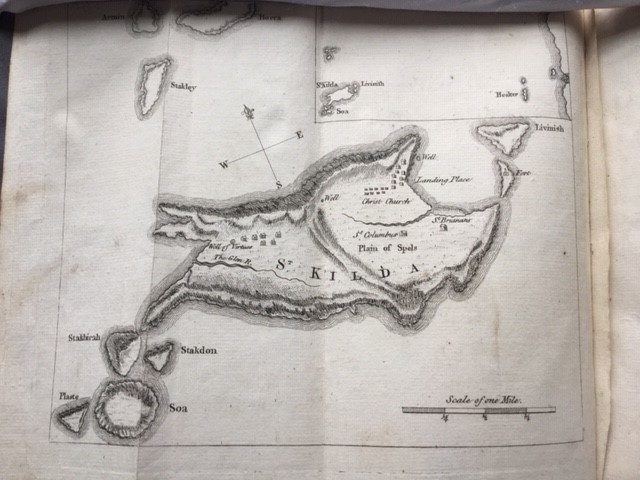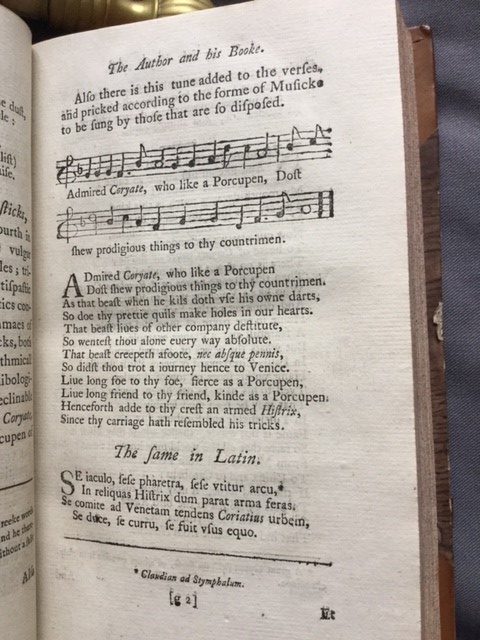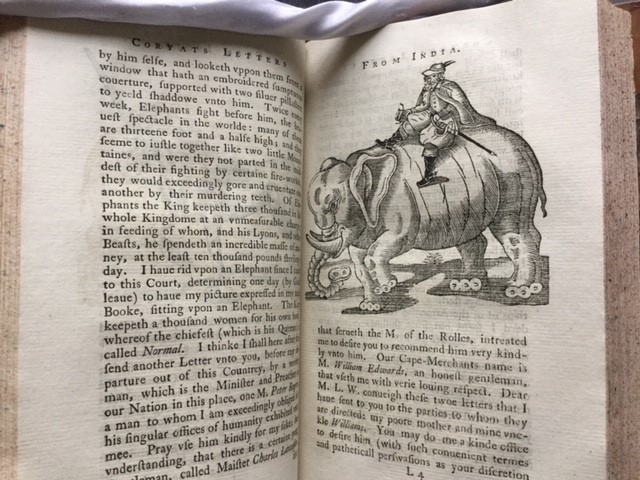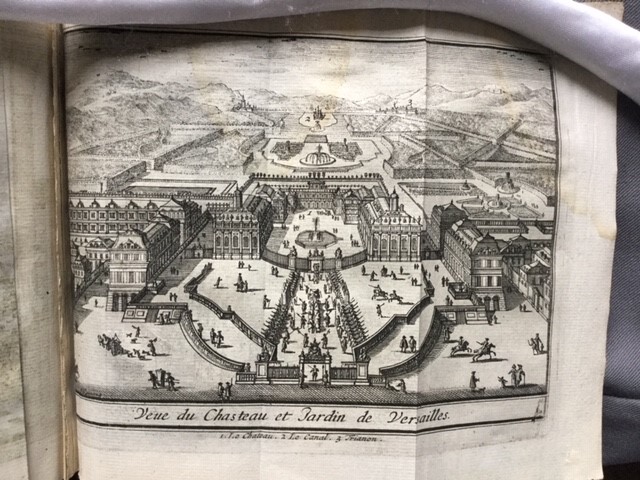Welcome to the second in a new series of blogs appearing throughout the year to interest, intrigue and, one hopes, entertain followers of the goings-on of Innerpeffray Library. The theme is a general one, but should deliver up something to pique everyone’s interest at some point. For those of you lucky enough to have visited the Library, you will have noticed that the shelves really do go from floor to ceiling and, as a result, there are some shelves that really do not get the attention that they perhaps deserve. This series aims to remedy this injustice by dragging out the ladder and going for a quick Tour of the Tops to see what gems there are awaiting true recognition! This ‘Episode’ continues the hunt as we slowly move around the top shelves of the Library. I would love to claim special access during these trying times, but the research for this article was done before the Library closed back in March!
So, a quick confession around the first book I am going to discuss… I knew it was up there somewhere! This is a book that has been on display at times in the Library and one that a number of volunteers – and the Keeper of course – are consequently aware of and told me to look out for it once I announced my intentions to embark on this journey. It is, though, worth highlighting here as it’s a fascinating account of St. Kilda, written by its local minister, a chap by the name of Kenneth MacAulay, in 1764. I should note, he was the minister for the parish of Ardnamurchan and so he was an infrequent traveller to the island as opposed to a resident. He does seem, however, to have been intrigued by life on this most remote island – situated over 100 miles from his own, already extremely remote, parish on the mainland. Even today, St. Kilda remains an oddity, with its only permanent inhabitants being military personnel, supplemented by various visitors and National Trust for Scotland employees. The resident population was evacuated in 1930, so this book offers an insight into what life was like as a native islander. As usual with these types of book, it is written for an audience of gentlefolk in the cities of Great Britain, so some of the language can be somewhat, shall we say, condescending – he refers to the islanders as “our domestic Indians”. There are, however, signs of respect for the compassion and generosity of the islanders. The book then delves into all sorts of details of the island – its geography, history, flora, fauna and daily life on the islands all get a mention in this book. It offers a really interesting account of this most unusual place and it is written in a very free-flowing style which makes it quite easy to delve into the book and keep going. Of course, there are plentiful classical illusions and comparisons as one would expect from a learned man of this era, but on the whole, it is an enjoyable read. A real delight and a book I can certainly recommend to anyone with a vague interest in St. Kilda!

The next book is also a travel book, but one that takes us a lot further than St. Kilda – all the way to India in fact! This is a quite remarkable book by a chap called Thomas Coryat (or Coryyat, Coryate or Coriat depending on what you’re reading!) who was a Jacobean gentleman who was court jester for a time to Prince Henry of Wales (eldest son of James VI). For some unknown reason, he decided to go for a long walk – around Europe! – and wrote up an account of the travels in a book. The Library’s copy dates from 1776 and includes various letters written from his lengthier later travels to Persia and India. The title of this work is “Coryat’s Crudities” and I’m still not quite sure why… It has some serious fascinating sections – this is one of those books that I will perhaps revisit in a later episode because there is so much to take in! However, I am going to focus on two aspects this time round. Firstly, as this includes a lot of material about Coryat as well as by him, there are some “extracts relating to him, from various authors”. My favourite of these is not just a piece of text. Oh no, this one is presented “according to the forme of Musick and to be sung by those that are so disposed”!! It’s quite the piece – comparing Coryat to a porcupine (I mean, who wouldn’t be flattered by that!). I will concede that the lyrics are not the best. Twice, the author is forced to jump into Latin to make the rhyme work and towards the end he just completely gives up and puts “Porcupen” twice, which is a distinct lack of effort if you ask me… Although, I can hardly accuse him of a lack of effort overall, as below you will see that he has written the same poem in LATIN as well. It really puts modern-day fans to shame, doesn’t it?

Back in the 17th Century, people wrote songs with a tune in multiple languages to express their admiration for people’s talents!! The second aspect, which I teased in the previous episode, is the attempt at Instagram! Firstly, see the text to the right:
Apologies that it’s not perfectly clear – in full, it reads “I have rid upon an Elephant since I came to this Court, determining one day (by God’s leave) to have my picture expressed in my own Booke, sitting upon an Elephant.” And here we have a picture of him sitting upon an elephant! Now, surely this is the 17th Century equivalent of posing for a photograph whilst doing a particularly unusual activity JUST for your social media postings? The thing that amuses me the most about this is that, well, we have no actual proof that he DID sit on an elephant – only his word! So, couldn’t he have lied about riding one and just got a drawing made of him doing so? Perhaps that’s just the cynic in me speaking out, but it’s certainly a fascinating insight into the mind of a man who thought it was worth travelling thousands of miles across multiple continents on foot! A most intriguing character indeed and one whose adventures I am sure I will discuss further in future episodes! Definitely worth a look next time you, dear reader, are in the Library!

The final book I want to introduce you to today is yet another one to which I shall endeavour to return later as well, because I am certain that there will be a lot more therein to share! For now, however, I shall focus on what I found at the end… This book has the most delightful title of “Les Délices de la France” or “Description des Provinces, Villes principals, Maisons Royales, Chateaux, & autres Lieux remarquables de ce beau Royaume” (to translate: The Delights of France or Description of the regions, main cities, royal palaces and the other notable places of this beautiful kingdom). In three small volumes, this book bounces around the entire kingdom of France as it was in 1728 – a decade or so after the Sun King had permanently set. It’s basically the forerunner to the Michelin guides that came out in the early 20th Century! It makes me think it is basically a French version of the amazing Britannia by William Camden that the Library has (albeit Britannia is over a century older). This is, unsurprisingly, in French, but anyone will appreciate what lies at the end of each of the three volumes: Cityscapes! Well, cityscapes and drawings of the more well-known “Maisons Royales”, as you will be able to see in the image to the right. It shows Versailles at the height of its importance in the world with the gardens stretching off into the far distance. I did not have as long as I would have liked to peruse all of the maps, but I found most of the major French cities – some twice – in the time I did have. I only had a brief glance at the actual text so taken was I with these cityscapes. Unlike the other two books I have discussed today, this one seems to have been less known and a bit more hidden on the shelves. It was borrowed once – by an intriguing chap noted as A. Du Pare in 1797. Intriguing because he was living at Drummond Castle and that is a very French sounding name! Perhaps he was a French visitor to the Drummonds, or maybe a native French tutor? Either way, it seems that this book is a bit more of a hidden treasure!

So that rounds off the second ‘episode’ of the Tour of the Tops. Hopefully, it has continued to prove interesting. I fear that there will now be a break until I can get back into the Library to continue the tour, so I cannot provide any teasers for the next episode. The joy is that I have genuinely no idea what I might come across next, so the surprise will be mine as well! I hope you will join me once again once I get back to the top shelves of Innerpeffray!
RS
